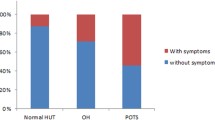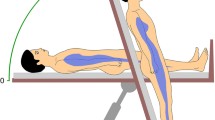Summary
OBJECTIVE: To evaluate the role of the Schellong test (ST) in forms of orthostatic dysregulation in comparison with the tilt-table test (TT). METHODS: 67 young males (mean age, 22 ± 4 years) from the military service, representing two different cohorts, were examined by ST and TT, which served as gold standard. 32 of the 67 subjects were asymptomatic while 35 had sought medical advice because of orthostatic complaints. The subjects subsequently were classified into four categories according to the TT: normal TT, orthostatic hypotension (OH), postural orthostatic tachycardia syndrome (POTS), and neurocardiogenic syncope (NCS). Chi-square test was used to calculate the sensitivity and specificity of ST in detecting forms of orthostatic dysregulation (OH, POTS and NCS). RESULTS: In total, TT detected 23 recruits with POTS, 16 with NCS and 2 with OH. Out of the 32 asymptomatic subjects only one was diagnosed having POTS by TT and ST, the rest had a normal ST and TT. For detecting POTS, ST sensitivity was 61% and specificity was 100% compared with TT. For detecting NCS, ST sensitivity was 31% and specificity 100% compared with the reference test, the TT. The data concerning OH could not be analyzed because of the small number of cases. CONCLUSIONS: In conclusion the results of our study indicate that ST can be used in first line in the diagnosis of patients with orthostatic symptoms by the medical practitioner. If the ST is normal, further examination by TT is indispensable, because sensitivity of ST concerning POTS and NCS is relatively low.
Zusammenfassung
ZIEL: Diese Studie untersucht die Rolle des Schellong-Tests (ST) im Vergleich zur Kipptischuntersuchung (KT) in der Evaluierung von Formen orthostatischer Dysregulation. METHODE: Wir untersuchten 67 Soldaten (mittleres Alter, 22 ± 4 Jahre) zweier unterschiedlicher Gruppen mittels ST und KT auf das Vorliegen orthostatischer Dysregulation. 32 Soldaten waren asymptomatisch; 35 hatten zuvor den Arzt wegen orthostatischer Beschwerden aufgesucht. Nach KT wurden die Probanden in folgende Kategorien eingeteilt: normale KT, orthostatische Hypotension (OH), posturales orthostatisches Tachycardia syndrome (POTS) und neurokardiogene Synkope (NKS). ERGEBNISSE: Mittels KT wurden bei 23 Soldaten POTS (11 von den 23 hatten zusätzlich eine NKS) diagnostiziert, bei 16 eine NKS und bei 2 eine OH. Von den 32 asymptomatischen Probanden wurde lediglich bei einem ein POTS mittels ST und KT diagnostiziert, der Rest wies bei beiden Tests normale Ergebnisse auf. Für die Diagnose POTS erreichte der Schellongtest eine Sensitivität von 61% und eine Spezifität von 100%, für die Diagnose NKS eine Sensitivität von 31% und eine Spezifität von 100%, jeweils bezogen auf den Referenztest, die KT. SCHLUSSFOLGERUNGEN: Da alle Probanden mit pathologischem ST auch bei der KT auffällig waren, ist der ST zwar für das Vorliegen einer orthostatischen Dysregulation beweisend, schließt aber bei normalem Ergebnis eine solche nicht aus. Aufgrund der niedrigen Sensitivität des ST bezüglich NCS und POTS ist daher auch bei normalen ST und klinischen Symptomen die Durchführung eines KT unverzichtbar.
Similar content being viewed by others
Author information
Authors and Affiliations
Corresponding author
Rights and permissions
About this article
Cite this article
Winker, R., Prager, W., Haider, A. et al. Schellong test in orthostatic dysregulation: a comparison with tilt-table testing. Wien Klin Wochenschr 117, 36–41 (2005). https://doi.org/10.1007/s00508-004-0288-5
Received:
Accepted:
Published:
Issue Date:
DOI: https://doi.org/10.1007/s00508-004-0288-5




